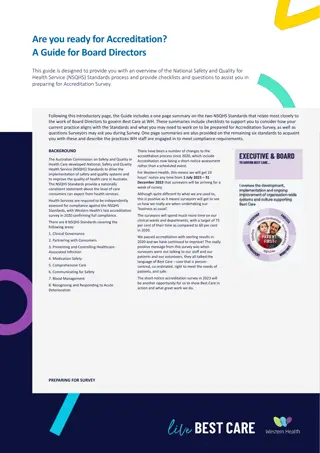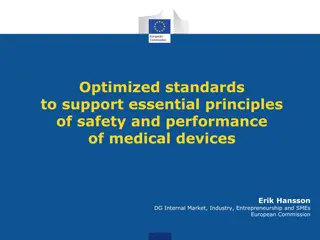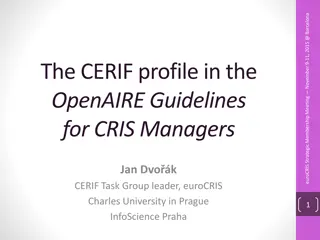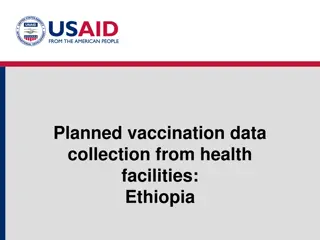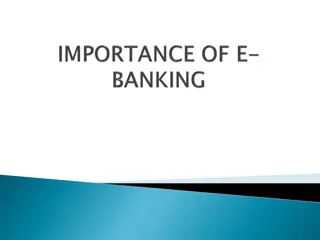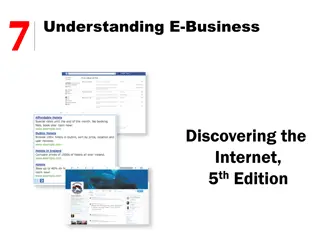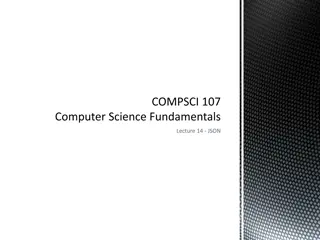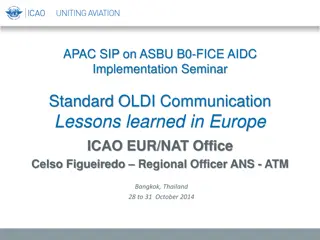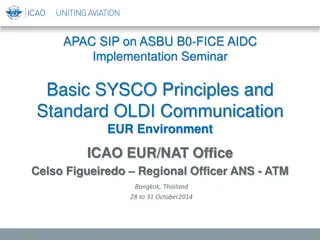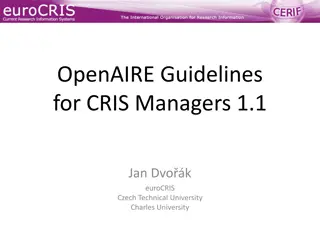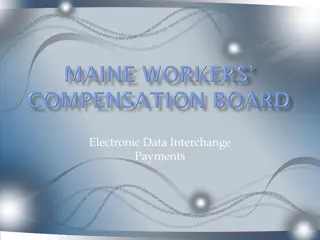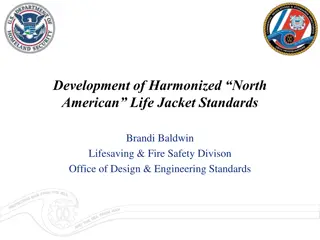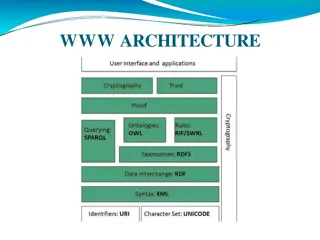Health Data Interchange Standards Overview
Explore the importance of data standards in healthcare, including HL7 standards, core requirements for data exchange, and choices for data interchange. Learn about HL7 v2 and v3 messaging standards, document standards, and the benefits of using HL7 v2 messaging standard. Understand why data interchange standards are essential for patient-centric EHR and secondary use of data. Discover the core elements needed for effective data exchange and the common vocabulary used in data communication.
Download Presentation

Please find below an Image/Link to download the presentation.
The content on the website is provided AS IS for your information and personal use only. It may not be sold, licensed, or shared on other websites without obtaining consent from the author. Download presentation by click this link. If you encounter any issues during the download, it is possible that the publisher has removed the file from their server.
E N D
Presentation Transcript
Networking and Health Information Exchange Health Data Interchange Standards : Lecture a This material (Comp 9 Unit 5) was developed by Duke University, funded by the Department of Health and Human Services, Office of the National Coordinator for Health Information Technology under Award Number IU24OC000024. This material was updated by Normandale Community College, funded under Award Number 90WT0003. This work is licensed under the Creative Commons Attribution-NonCommercial-ShareAlike 4.0 International License. To view a copy of this license, visit http://creativecommons.org/licenses/by-nc-sa/4.0/
Health Data Interchange Standards Learning Objectives Understand the need to have data standards Understand the standards that are in place today, or are being adopted Learn about HL7 standards and implementation Understand HL7 messaging standards and the basic HL7 transaction types 2
Why Use Data Interchange Standards? Concept of patient-centric EHR requires aggregation of data from across all sites of care Secondary use of data likely requires the movement of data When sender and receiver are not known in advance of data exchange, standard is mandatory 3
Core Requirements for Data Exchange Nouns: Items we wish to communicate Typically physical things (persons, places) and actions Phrases: Essential bindings between nouns An action happens to a person One action causes another A person performs an action Vocabulary & model: Common definitions Assume common perspective Prescribe the nouns and phrases we can use 4
Choices for Data Interchange HL7 v2.n and v3 messaging standards for clinical data Document standards HL7 Clinical Document Architecture HL7 Continuity of Care Document ASTM Continuity of Care Record DICOM for images and other media Claims standards Prescription standards 5
HL7 v2.n Messaging Standard Easy to use and understand Based on an implicit information model Focused initially on needs of HIS Later versions expanded horizontally into other areas Including ambulatory care Most widely used data exchange standard >95% provider organizations Saves money on cost of interfaces Events not tightly coupled to profiles Makes no formal attempt to define process 6
HL7 v2.n Messaging Standard Works well within a single enterprise Where both sender and receiver are tightly coupled Does not work well when sender and receiver are not connected Available with delimiter or with XML syntax Messages initiated by trigger events Clinical data sent as name-value pairs 7
HL7 v2.n Messaging Standard Message composed of segments whose content is defined by position Segments are made up of data fields which are made up of data elements Fields may be repeating Accommodates HL7 registered terminology expressed as code, name, terminology ID triplet Local tailoring using Z-segments 8
Version 2 Messages composed of Segments composed of o Fields composed of Components Delimiters Field separator: | Component separator: ^ Repetition separator: ~ Escape character: \ Subcomponent: & Segment terminator: <cr> 9
HL7 Messages Composed of reusable segments, each identified by a 3-letter mnemonic All messages must start with header segment MSH which includes sender, receiver, date-time, message identifier, message type, and trigger event Segments used in a message are determined by message type 10
HL7 Basic Transaction Model Lab system Admit patient Receive A01, send ACK trigger event send HL7 ADT A01 msg Interface Engine receive HL7 ACK msg ADT system Source: W. Ed Hammond, PhD 11
Patient Admission Scenario, Inform Lab System Trigger event is admission : A01 Message type is: ADT Messages composed of: MSH (message header) PID (patient identification) PV1 (visit data) 12
Message Header Segment - MSH Sending Unit Receiving Unit Date Time Message type Trigger ID MSH|^~|&|SMS|OR2|TMR|SICU|201010191535|password|ADT^A01|MSG1632|P|2.7<cr> Delimiters production version Sending Place Message Number Receiving Place Source: W. Ed Hammond, PhD 13
PID Segment 1/3 Method Middle Initial Check digit First Suffix Patient ID Last name PID|Z12345^5^M11||||PATIENT^JOSEPH^M^IV| Patient name Null fields Data field Field delimiter Source: W. Ed Hammond, PhD 14
PID Segment 2/3 Mother s maiden name Street address Date of birth Race MAIDEN|19610605|M||C|1492 OCEAN STREET^ Gender Component delimiter Data component Source: W. Ed Hammond, PhD 15
PID Segment 3/3 Telephone State County City Zip Code DURHAM^NC^27705|DUR|(919)684-6421<cr> Segment terminator Source: W. Ed Hammond, PhD 16
PV1 Segment Sequence number Service PV1|1|1|N2200^2200|||OR^02|0846^WELBY^MARCUS^G||SUR<cr> Patient class Patient location Attending Source: W. Ed Hammond, PhD 17
OBR Segment Placer order number Filler order number Universal service ID Text order Local set OBR|1|330769.0001.001^DMCRES|0000514215^RADIS1|77061^U/S PEVLIC^L ||201010211145|||||||||||||0491909||||U999|M||||||^FIBROIDS, R/O|207484^ CARROLL&BARBARA&A|||089657&BROWN&JOANNE<CR> Requested date-time of service Reason for study Principal results interpreter Source: W. Ed Hammond, PhD 18
Typical Result Message - ORU MSH|^~\&|||||19981105131523||ORU^R01<cr> PID|||100928782^9^M11||Smith^John^J<cr> OBR||||Z0063-0^^LN<cr> OBX||XCN|Z0063-0^^LN||2093467^Smith^J^<cr> OBX||Z0092-0^^LN||203BE0004Y^^X12PTX<cr> Data field Data component segment Source: W. Ed Hammond, PhD 19
OBX The Flexible Segment Data value Identifying code for data element Terminology source Data type Data units OBX||NM|11289-6^^LN||38|C^^ISO+|||||F LOINC numeric Temperature reading coded as a LOINC term with a value of 38 degrees Centigrade; final report Status: final Note: code-value pair construction Other data fields include: date of observation, identity of provider giving observation, normal ranges, abnormal flags Source: W. Ed Hammond, PhD 20
OBX with Coded Value Data type = coded LOINC code for ABO Blood Group SNOMED code for Group O OBX||CE|883-9^Blood Group^LN||F-D1250^Group O^SM| Identifies test Identifies result Source: W. Ed Hammond, PhD 21
V2.4 Delimiter Based (1/2) MSH|^~\&|REGADT|MCM|IFENG||199112311501||ADT^A04^ADT_A01|000 001|P|2.4||| EVN|A04|199901101500|199901101400|01||199901101410 PID|||191919^^GENHOS^MR~371-66- 9256^^^USSSA^SS|253763|MASSIE^JAMES^A||19560129|M|||171 ZOBERLEIN^^ ISHPEMING^MI^49849^""^||(900)485-5344|(900)485- 5344||S^^HL70002| C^^ HL70006|10199925^^^GENHOS^AN|371-66-9256|| NK1|1|MASSIE^ELLEN|SPOUSE^^HL70063|171OBERLEIN^^ISHPEMING ^MI^49849^" ^|(900)485-5344| (900)545-1234~(900)545-1200|EC1^FIRST EMERGENCY CONTACT^HL70131 NK1|2|MASSIE^MARYLOU|MOTHER^^HL70063|300 OBERLEIN^^ISHPEMING ^MI^49849^" ^|(900)485-5344|(900)545- 1234~(900)545-1200|EC2^SECOND EMERGENCY CONTACT^HL70131 NK1|3|||123 INDUSTRY WAY^^ISHPEMING^MI^49849^""^||(900)545-1200 |EM^EMPLOYER^HL70131|19940605||PROGRAMMER|||ACME SOFTWARE COMPANY 22
V2.4 Delimiter-Based (2/2) PV1||O|O/R||||0148^ADDISON,JAMES|0148^ADDISON,JAMES||AMB|||||| |0148^ADDISON,JAMES|S|1400|A|||||||||||||||||||GENHOS|||||199501101410| PV2||||||||199901101400|||||||||||||||||||||||||199901101400 ROL||AD|CP^^HL70443|0148^ADDISON,JAMES OBX||NM|3141-9^BODY WEIGHT^LN||62|kg|||||F OBX||NM|3137-7^HEIGHT^LN||190|cm|||||F DG1|1|19||0815^BIOPSY^ACODE||00| GT1|1||MASSIE^JAMES^""^""^""^""^||171 ZOBERLEIN^^ISHPEMING^MI^49849^" ^|(900)485-5344|(900)485-5344 ||||SE^SELF^HL70063|371-66-925||||MOOSES AUTO CLINIC| 171 ZOBERLEIN^^ISHPEMING^MI^49849^""|(900)485-5344| IN1|0|0^HL70072|BC1|BLUE CROSS|171 OBERLEIN^^ ISHPEMING^M149849^""^||(900)485-5344|90||||||50 OK|<cr> 23
V2.n XML-Based xmlns="urn:hl7-org:v2xml" xmlns:xsi="http://www.w3.org/2001/XMLSchema-instance" xsi:schemaLocation="urn:hl7-org:v2xml ADT_A01.xsd"> <MSH> <MSH.1>|</MSH.1> <MSH.2>^~\&</MSH.2> <MSH.3> <HD.1>REGADT</HD.1> </MSH.3> <MSH.4> <HD.1>MCM</HD.1> </MSH.4> <MSH.7> <TS.1>201010191501</TS.1> </MSH.7> <MSH.9> <CM_MSG.1>ADT</CM_MSG.1> <CM_MSG.2>A04</CM_MSG.2> <CM_MSG.3>ADT_A01</CM_MSG.3> </MSH.9> </MSH> Source: W. Ed Hammond, PhD 24
v2 Functional Areas ADT Registration Orders Results Patient financial Query language Immunization reporting Clinical trials Adverse drug reactions Scheduling Referrals Medical records Patient care Problem lists and goals Waveforms Personnel management Clinical lab automation transactions Master files 25
Health Data Interchange Standards Summary Lecture a Data exchange standard, HL7 v2.n It is based on an implicit model, and therefore is not, in itself, interoperable. Most used in US because of its simplicity, ease of use, and flexibility This standard works very well in an enclosed environment (sender and receiver known and use business agreements) Requires cooperation and agreement between vendors 26
Health Data Interchange Standards References Lecture a References Acknowledgement: Material used in this lecture comes from the following source Introduction to HL7 Standards. (n.d.). Retrieved January 18, 2012, from Health Level Seven International website: http://www.hl7.org/implement/standards/index.cfm Images Slide 11: Source: W. Ed Hammond, PhD Slide 13: Source: W. Ed Hammond, PhD Slide 14: Source: W. Ed Hammond, PhD Slide 15: Source: W. Ed Hammond, PhD Slide 16: Source: W. Ed Hammond, PhD Slide 17: Source: W. Ed Hammond, PhD Slide 17: Source: W. Ed Hammond, PhD Slide 18: Source: W. Ed Hammond, PhD Slide 19: Source: W. Ed Hammond, PhD Slide 20: Source: W. Ed Hammond, PhD Slide 21: Source: W. Ed Hammond, PhD Slide 24: Source: W. Ed Hammond, PhD 27
Health Data Interchange Standards Lecture a This material was developed by Duke University, funded by the Department of Health and Human Services, Office of the National Coordinator for Health Information Technology under Award Number IU24OC000024. This material was updated by Normandale Community College, funded under Award Number 90WT0003. 28








